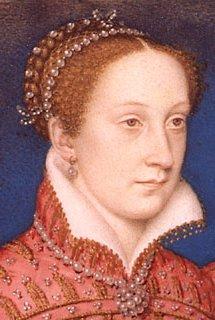
Mary Queen of Scots, Clouet, 1558. Photo: Royal Collection.
‘All I can tell you is that I account myself one of the happiest women in the world‘ – Mary, Queen of Scots to her mother on the morning of her wedding.
The ill fated wedding of Mary Stuart, Queen of Scotland and the Dauphin François of France took place on the 24th April 1558 at Notre Dame Cathedral in Paris. The young couple had been closely raised together since they were small children and so were the very best of friends and must have felt more like siblings than man and wife.
The fourteen year old groom was the eldest son of Henri II and Catherine de’ Medici, whose birth had occasioned great joy throughout France as it came after eleven years of apparently barren marriage. Adored by his parents and grandfather, François I, the boy nonetheless grew up timid, stammering, sickly and undersized.
In bleak comparison, his fifteen year old bride was tall for her age; gorgeous with long auburn hair and sparkling hazel eyes; blessed with splendid health and full of vivacity, confidence and good humor. It’s clear that Mary sincerely loved François but in a maternal, sisterly way only, while he, understandably, adored her.
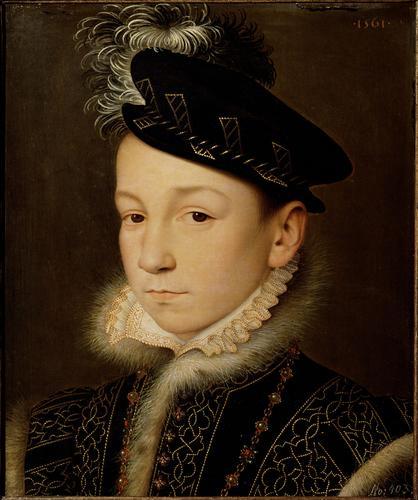
Francois II, Clouet, c1558.
Their marriage had been decided when Mary was just five years old and she had lived in France ever since, fully aware that it was her destiny both to marry the Dauphin and then, in due course, one day become Queen of France as well as Scotland. I see echoes of Marie Antoinette and Louis XVI here – a strong willed, impetuous Queen longing for romance and adventure coupled with a less dashing husband. It doesn’t always have to be a recipe for disaster though – I expect things would have turned out very differently for everyone if François had lived into adulthood with Mary at his side.
Their wedding was an opulent affair, with preparations going on for months in advance for the big day. All of Paris was expected to turn out to celebrate with the royal family and the route between the Palais de Louvre and Notre Dame would have been cleaned and decorated with allegorical symbols, flowers and banners richly decorated with the fleur de lys of France and the bride’s personal emblem, the marigold. Elsewhere in the city, temporary theatres were constructed to host plays and food and drink vendors would have been preparing for a busy and lucrative day as they catered for the thousands who would line the procession way and then throng in the square in front of Notre Dame.
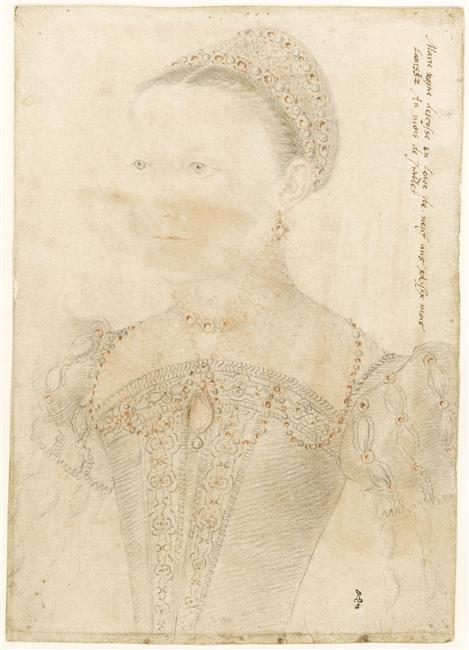
Mary Queen of Scots, Clouet, c1553. Photo: Bibliotheque Nationale de France.
The procession started just before midday and the thousands of spectators lining the route cheered as first the Swiss Guards marched to Notre Dame, followed by dozens of musicians, then one hundred gorgeously dressed King’s Gentlemen. After this came the princes, three bishops and then a group of cardinals carrying crucifixes and holy relics which the crowd would have bowed their heads at in reverence.
After the cardinals, there came the royal family, splendidly dressed, with their fabulous jewels gleaming and glittering in the spring sunlight. The crowd would have gone wild with excitement when they spotted the King himself accompanying the bride, the beautiful Queen of Scots who was, according to an eyewitness, ‘dressed in clothing as white as lilies, made so sumptuously and richly it would be impossible to describe. Two young ladies carried the marvellously long train’ while ‘round her neck was a pendant of inestimable value, with chokers, gems, and other magnificent riches. On her head she wore a gold crown ornamented with pearls, diamonds, rubies, sapphires, emeralds. In the middle of the crown was a fine red jewel (a “carbuncle” stone) valued at 500,000 écus or more.‘
Agnes Strickland wrote in 1852 that Mary wore ‘a robe whiter than the lily, but so glorious in its fashion and decorations that it would be difficult, nay, impossible, for any pen to do justice to its details. Her regal mantle and train were of a bluish-grey cut velvet, richly embroidered with white silk and pearls. It was of a marvelous length, full six toises (12 yards), covered with precious stones, and was supported by young ladies.’
Mary’s choice of a white wedding dress was an unusual one, particularly as white was more traditionally worn by royal ladies when they were in dieul blanc mourning but in this as in other things the strong willed Mary may well have been an innovator, keen to not just impress her own taste on her wedding day (after all, she hadn’t been allowed the privilege of choosing her groom) but also emphasize her virginity and show off her famously pale redheaded beauty, which would have been accentuated by a pure white dress.
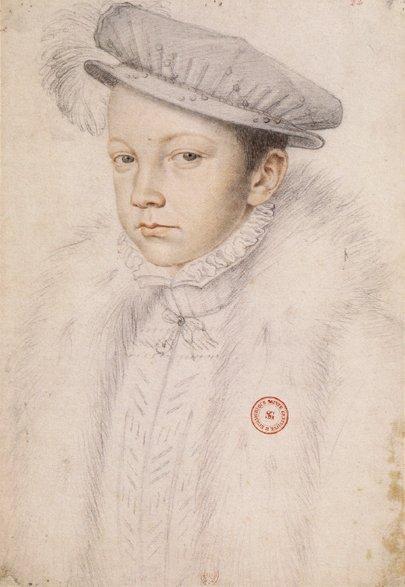
Francois II, Clouet, 1558. Photo: Bibliotheque Nationale de France.
At the end of the procession came Catherine de’Medici leading all the court ladies and princesses including Diane de Poitiers and the four year old Princesse Marguerite, all dressed in splendidly elaborate new gowns and blazing with jewels and pearls of every description. The ladies of the French court have been the epitome of glamour and exquisite taste for centuries and I expect that even our most frenzied imaginings of gold thread, pearls and silk couldn’t begin to touch what they looked like on that glorious April day.
Once the procession had safely reached Notre Dame, they entered through a side door, proceeded down the aisle and emerged again at a podium which had been erected at the main door and festooned with blue silk embroidered with gold fleur de lys for the occasion. There, the King, Archbishop of Rouen and bride and groom took their positions for the public wedding ceremony in front of the hushed and probably slightly tearful crowd, who cheered and shouted their congratulations when the blessed gold ring was placed on Mary’s finger and they were declared husband and wife before they all vanished into the cathedral again.
After this, the bride’s vainglorious uncle, the Duc de Guise mounted the stage and threw several handfuls of gold and silver coins, the traditional largesse into the huge crowd, causing a riot as people dived and fought for the precious coins. Ah, what would weddings be like without an embarrassing uncle?
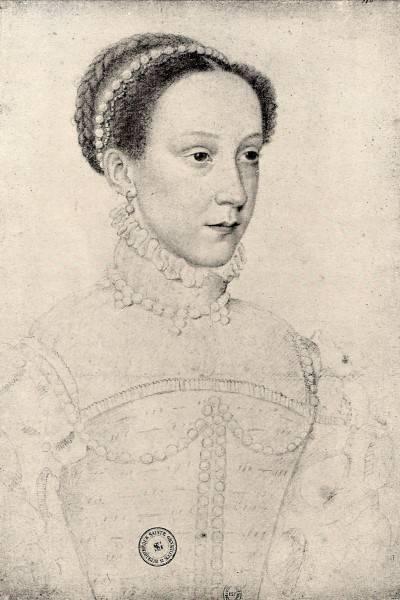
Mary Queen of Scots, Clouet, 1558. Photo: Bibliotheque Nationale de France.
The wedding guests would have been vaguely aware of the tumult outside as they now took their seats in the gorgeous but gloomy cathedral for the wedding mass. All eyes would have been upon the tall willowy figure of the bride in her shimmering white gown as she took her young husband’s hand then knelt before Archbishop of Rouen at the great altar while the coloured light from the great windows above them spilled like broken rainbows on the stone floor.
After the wedding, there was another grand procession back to the palace for the start of the official wedding celebrations, which were to last for fifteen days and included all manner of balls, banquets, parades and novel wonderments before closing with a huge tournament at the Palais de Tournelles in the Marais.
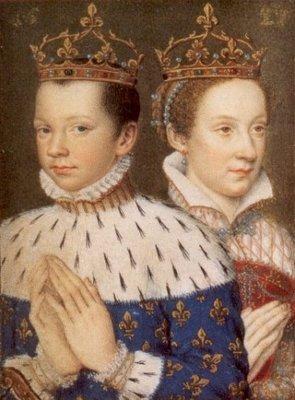
Mary Queen of Scots and Francois II, unknown artist, 1558. Photo: Bibliotheque Nationale de France.
In recent years, Mary, the young Queen of a rather impoverished country had suffered all manner of financial and sartorial embarrassments as she tried her best to establish her own household and Keep Up With The Valois with extremely limited fiscal means. Now though, as she surveyed her wedding guests and looked down with satisfaction at her gorgeous gown and the priceless jewels that hung around her neck (her exquisite diamond studded crown was so heavily overloaded with jewels that a fortunate courtier was given the job of holding it above her head as she presided over her nuptial banquet) she must truly have thought herself fortunate indeed.
